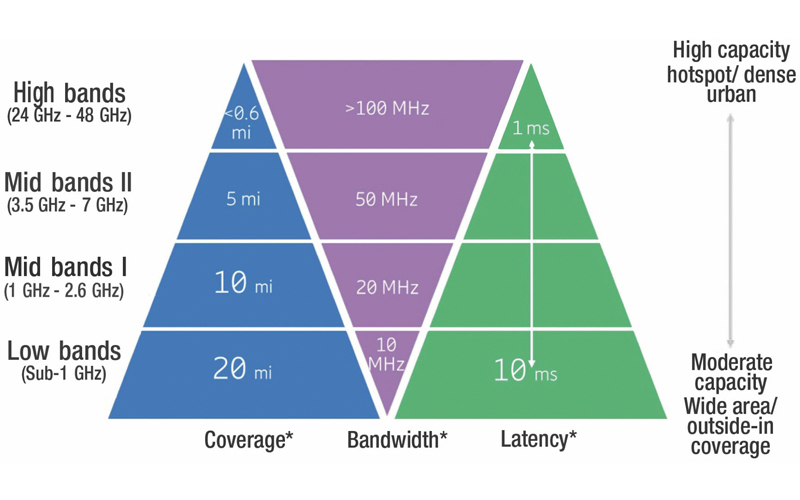Science & Technology
Millimetre Wave band in 5G
- 15 Jan 2022
- 7 min read
For Prelims: Millimetre Wave band, 5G, Low-Earth Orbit (LEO), Satellite Industry, Spectrum, International Telecommunication Union
For mains: 5G technology, mm Wave bands of 5G and concerns related to it, Satellite Communication, International Telecommunication Union.
Why in News
Recently, Satcom Industry Association-India (SIA) has voiced concerns over the Government’s plan to include the Millimetre Wave (mm Wave) bands in the 5G spectrum auction
- SIA is an industry body that represents the interests of the communication satellite ecosystem in India.
- Telecom Regulatory Authority of India (TRAI) had sought industries’ views on topics related to quantum of spectrum to be auctioned off.
Key Points
- 5G Technology:
- About:
- 5G is the 5th generation mobile network. It is a new global wireless standard after 1G, 2G, 3G, and 4G networks. The 5G networks will operate in the mm Wave spectrum.
- It enables a new kind of network that is designed to connect virtually everyone and everything together including machines, objects, and devices.
- Bands in 5G: 5G mainly work in 3 bands, namely low, mid and high frequency spectrum — all of which have their own uses as well as limitations.
- Low band spectrum: It has shown great promise in terms of coverage and speed of internet and data exchange however the maximum speed is limited to 100 Mbps (Megabits per second).
- Mid-band spectrum: It offers higher speeds compared to the low band, but has limitations in terms of coverage area and penetration of signals.
- High-band spectrum: It has the highest speed of all the three bands, but has extremely limited coverage and signal penetration strength.
- Internet speeds in the high-band spectrum of 5G has been tested to be as high as 20 Gbps (gigabits per second), while, in most cases, the maximum internet data speed in 4G has been recorded at 1 Gbps.
- About:
- Millimetre Wave-Band:
- About:
- It is a particular segment of the radio frequency spectrum that ranges between 24 GHz and 100 GHz.
- This spectrum, as the name suggests, has a short wavelength, and is appropriate to deliver greater speeds and lower latencies. This in turn makes data transfer efficient and seamless as the current available networks work optimally only on lower frequency bandwidths.
- Significance:
- 5G services can be deployed using lower frequency bands. They can cover greater distances and are proven to work efficiently even in urban environments, which are prone to interference.
- But, when it comes to data speeds, these bands fail to hit peak potential needed for a true 5G experience. So, mmWave is that quintessential piece in the 5G jigsaw puzzle for mobile service providers.
- Effect on Satellite Industry:
- The Internet has largely been provided to users via fibre-optic based broadband connectivity or mobile network. Of late, another class of Internet vendors is showing up. These are satellite-based communication service providers.
- This segment uses Low-Earth Orbit (LEO) satellites to provide broadband to both urban and rural users. Their service could also be used for weather predictions.
- The mm- band had been the subject of controversy due to out-of-band emissions into the passive satellite band used for weather satellites at 23.6-24 GHz.
- Out-of-band emission is emission on a frequency or frequencies immediately outside the necessary bandwidth which results from the modulation process.
- The level of out-of-band emission can not be reduced without affecting the corresponding transmission of information.
- About:
- Concerns Raised by the Industry:
- Against ITU Norms:
- SIA urged the regulator to limit the inclusion of mmWave spectrum in the 5G auction as 27.5-31 GHz and 17.7-21.2 GHz bands have been preserved for satellite-based broadband services as per the decision taken by the International Telecommunication Union (ITU).
- The industry body pointed to Europe’s “5G Roadmap”, which is built on the ITU’s decision to hold these bands for satellite-based broadband services.
- Denial of Benefits:
- It also noted that offering excessive spectrum resources in the upcoming 5G auction will result in Indian citizens being denied the benefits of high-demand, advanced satellite broadband services.
- Loss to Economy:
- It will result in a massive loss to the Indian economy of up to USD 184.6 billion by 2030, along with the loss of Foreign Direct Investment (FDI) and employment generation benefits.
- Against ITU Norms:
- SIA’s Suggestions:
- SIA-India has noted that the 330 MHz of spectrum in the 3.3-3.67 GHz band is enough to satisfy India’s mid-band 5G needs while ensuring a competitive auction.
- The industry body also noted that providing excess spectrum could pose a downside risk of the bands going unsold, or even worse, underutilised by terrestrial players at the expense of satellite-based service providers.The allocation of mmWave band is critical to the satellite communication industry, which needs a stronger regulatory support to ensure that 5G operations don’t interfere with their existing operations.





